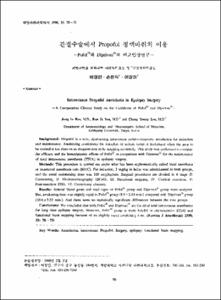KUMEL Repository
1. Journal Papers (연구논문)
1. School of Medicine (의과대학)
Dept. of Anesthesiology & Pain Medicine (마취통증의학)
간질수술에서 Propofol 정맥마취의 이용
- Keimyung Author(s)
- Bae, Jung In; Son, Eun Ik; Lee, Chang Young
- Journal Title
- 대한마취과학화지
- Issued Date
- 1998
- Volume
- 35
- Issue
- 1
- Abstract
- Background: Propofol is a new, short-acting intravenous sedative-hypnotic anesthetics for induction and maintenance. Awakening craniotomy for resection of seizure focus is performed when the area to be excited is too close to an eloquent area to be mapping accurately. This study was performed to evaluate the efficacy and the hemodynamic effects of Pofol® in comparison with Diprivan® for the maintenance of total intravenous anesthesia (TIVA) in epilepsy surgery.
Methods: This procedure is carried out under what has been euphemistically called local anesthesia or monitored anesthesia care (MAC). For induction, 2 mg/kg in bolus was administered in both groups, and the usual maintaining dose was 100 mcg/kg/min. Surgical procedures are divided in 6 stage (I: Craniotomy, II: Electrocorticography (ECoG), III: Functional mapping, IV: Cortical resection, V: Post-resection EEG, VI: Craniotomy closure).
Results: Arterial blood gases and vital signs of Pofol® group and Diprivan® group were analysed. But, awakening time was slightly rapid in Pofol® group (8.9 2.64 min.) compared with Diprivan® group (10.6 3.22 min.). And there were no statistically significant differences between the two groups.
Conclusions: We concluded that both Pofol® and Diprivan® are the ideal total intravenous anesthetics for long time epilepsy surgery. However, Pofol® group is more helpful in intraoperative ECoG and functional brain mapping because of its slightly rapid awakening time. (Korean J Anesthesiol 1998; 35: 70∼75)
- Alternative Title
- Intravenous Propofol Anesthesia in Epilepsy Surgery
- Publisher
- School of Medicine
- Citation
- 배정인 et al. (1998). 간질수술에서 Propofol 정맥마취의 이용. 대한마취과학화지, 35(1), 70–75.
- Type
- Article
- ISSN
- 0302-5780
- 파일 목록
-
-
Download
 oak-bbb-05537.pdf
기타 데이터 / 331.65 kB / Adobe PDF
oak-bbb-05537.pdf
기타 데이터 / 331.65 kB / Adobe PDF
-
Items in Repository are protected by copyright, with all rights reserved, unless otherwise indicated.